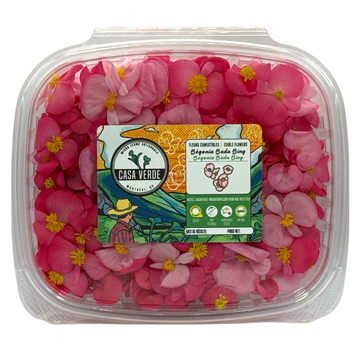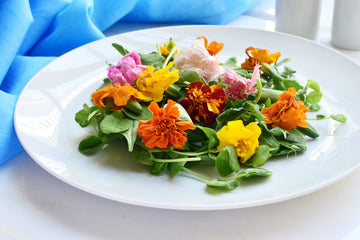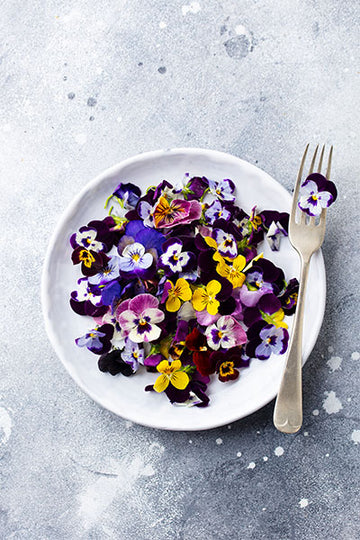Begonia Edible Flowers

Freshly Harvested

Non-GMO & Natural

Nutrient Dense

Trusted by Chefs
*This is a seasonal product. Only Available May-September
(65+ Flowers in each clamshell product)
Begonias are a total sleeper hit in the edible flower world. Unlike many flowers that are mostly for show, begonia petals actually taste amazing: crisp, juicy, citrusy-sour (oxalic acid gives them a tang similar to sorrel or rhubarb). They’ve got both visual appeal and bold flavor, which makes them a chef’s dream.
Begonia Edible Flowers
Begonia flowers bring both striking beauty and surprising flavor to the plate. With their vivid colors and crisp, citrusy bite, they’re a standout choice for chefs looking to go beyond garnish and introduce a true flavor element with their edible blooms.
✔ Flavor Profile – Bright, citrusy, and tangy with a sorrel-like acidity. Juicy and refreshing, these petals bring more than just looks.
✔ Culinary Uses – Adds a pop of tartness to desserts, fruit salads, and cocktails, while also pairing beautifully with seafood and rich proteins. Their crisp texture and bold colors make them as versatile as they are stunning.
✔ Visual Appeal – Vibrant blooms in shades of red, pink, orange, and yellow — a lively, tropical accent for high-end plating.
🌸 Pairing Suggestions
Begonia edible flowers pair beautifully with:
-
Proteins – seared scallops, oysters, lobster, grilled chicken.
-
Fruits & Veg – strawberries, mango, pineapple, melon, cucumbers, tomatoes.
-
Desserts – sorbets, citrus tarts, cheesecakes, pavlovas.
-
Cocktails – margaritas, mojitos, gin-based cocktails, sparkling wine.
-
Salads & Starters – mix into citrus-forward salads or use as a tart garnish for ceviche.
Chefs love begonia flowers for their dual purpose: they’re visually dazzling and bring a burst of bright, tangy flavor that balances sweet and savory dishes alike.

Begonia Edible Flowers

Let’s Manifest Beauty.
Edible Flowers that Smile.
Edible flowers are more than just decoration — they’re a chef’s secret for adding elegance, fragrance, and subtle flavor to a dish. From citrusy marigolds to honey-sweet alyssum and tangy begonias, these delicate blooms transform plates into experiences. Each petal offers color, aroma, and taste, turning simple ingredients into a culinary statement.

Flowers are here to stay
The Art of Garnishing with Edible Flowers
A garnish should do more than decorate — it should enhance. Edible flowers bring color, fragrance, and subtle flavor to the plate, turning simple dishes into memorable experiences. From delicate petals scattered across a salad to a single bloom crowning a dessert, flowers add elegance and elevate presentation in ways that engage every sense.
The Secret Ingredient Chefs Trust
Widely used in professional kitchens, microgreens enhance flavor profiles while adding nutrition and a striking visual appeal to everything from sandwiches to fine dining creations.
Frequent Asked Questions
Q: What are Microgreens?
Microgreens are young, tender plants harvested just after the first leaves develop. They’re packed with flavor, color, and nutrients, making them both delicious and healthy.
Q: Are microgreens really more nutritious than regular vegetables?
Yes. Research shows that microgreens can contain up to 40x more vitamins and antioxidants (like A, C, K, and E) compared to their mature counterparts.
Q: How do I use microgreens in my meals?
They’re incredibly versatile—use them as a garnish, in salads, on sandwiches, in wraps, smoothies, soups, or even as a centerpiece ingredient in gourmet dishes.
Q: How long do microgreens stay fresh?
Stored properly in a fridge, microgreens typically last 5–7 days. To keep them at peak freshness, store them dry in a breathable container.











